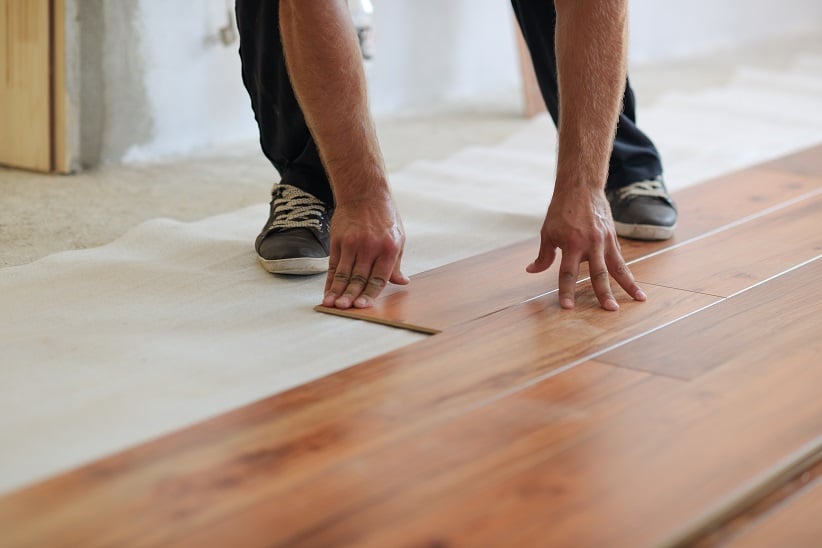Ever dream of swapping out your dated tile floors for sleek, modern vinyl without the hassle of demolition? You’re not alone! Many homeowners seek the practicality and style of vinyl flooring, but the question arises: can you lay it directly over existing tile?

Image: viewfloor.co
The answer, thankfully, is often yes! But understanding the intricacies of this process is crucial. From prepping the tile surface to selecting the right vinyl, there are considerations to ensure a successful and long-lasting installation.
Understanding the Pros and Cons
Advantages
Laying vinyl flooring over tile offers a tempting shortcut for several reasons:
- Time and Cost Savings: Removing old tile is a messy and labor-intensive undertaking. Opting for a vinyl overlay bypasses this, saving both time and money.
- Minimal Disruption: No need to tear up existing floors, minimizing dust and debris throughout your home.
- Flexibility and Versatility: Vinyl is a versatile material, offering a wide range of styles, colors, and textures to complement various décor.
- Ease of Installation: Compared to tile installation, laying vinyl flooring is often deemed easier, especially for DIYers.
Disadvantages
While enticing, there are also potential drawbacks, crucial to be aware of before starting:
- Added Thickness: Every layer of flooring increases overall height. This might pose problems with door clearances or appliances.
- Uneven Surfaces: Laying vinyl over uneven tile surfaces may result in inconsistencies, affecting the final look.
- Potential for Uneven Wear: Over time, the vinyl may wear unevenly, especially around high-traffic areas.
- Limited Lifespan: Compared to a direct tile installation, the longevity of vinyl over tile might be slightly shorter.

Image: imagetou.com
Essential Considerations
1. Tile Condition:
The condition of your existing tile is paramount. Inspect it for:
- Cracks or Chips: These must be repaired before installing vinyl to prevent compromising its surface.
- Grout Lines: Wide or uneven grout lines can create an uneven surface, making it difficult for a smooth vinyl overlay.
- Loose Tiles: Ensure all tiles are firmly attached to the subfloor to avoid movement and bumps beneath the vinyl.
2. Choosing the Right Vinyl:
Different types of vinyl flooring offer various benefits depending on your needs. For tile overlays, you’ll typically want a thicker, more robust vinyl to withstand the added challenge of an uneven surface.
- Luxury Vinyl Plank (LVP): A premium choice known for its durability, water resistance, and realistic wood-look aesthetics. LVP typically has a thicker backing, making it suitable for installation over tile.
- Luxury Vinyl Tile (LVT): Ideal for mimicking natural stone or tile, LVT is generally thinner than LVP. However, choose thicker options with a strong core for installation over tile.
- Sheet Vinyl: A budget-friendly option, but may not offer the same durability or aesthetic versatility as LVP or LVT. Consider it carefully for tile overlays due to its thinner construction.
3. Surface Preparation:
Thorough preparation is key to a successful outcome. Before vinyl installation:
- Cleaning: Sweep, mop, and ensure the tile surface is free of dust, grime, or residues that can hinder adhesion.
- Grout Sealing: Seal grout lines to prevent moisture from seeping and damaging the vinyl over time.
- Leveling: If significant unevenness exists, consider a self-leveling compound to create a smoother surface, ideal for vinyl installation.
- Primer: A primer helps improve adhesion and helps the vinyl lay flat, especially when dealing with porous tile or a highly non-uniform surface.
Installation Methods:
Two primary methods are employed for laying vinyl over tile:
1. Glue-Down Installation:
This method entails gluing the vinyl planks or tiles directly to the prepared tile surface. It offers superior durability and adhesion, especially in high-traffic areas. However, it requires meticulous surface preparation to prevent bubbling or unevenness.
2. Floating Installation:
As the name suggests, this method involves installing vinyl planks or tiles over an underlayment, creating a “floating” floor that’s not directly attached to the subfloor. While easier and quicker to install, it may not provide the same level of stability as a glue-down method, especially over uneven tile surfaces.
Tips for Success:
- Measure Twice, Cut Once: Precision is paramount. Carefully measure and cut planks or tiles to ensure a seamless and aesthetically pleasing finish.
- Stagger Seams: For a more durable and aesthetically appealing installation, avoid placing seams from one row directly above the seams in the previous row.
- Proper Tools: Invest in quality tools like a utility knife, measuring tape, and a rubber mallet to help ensure accurate cuts and secure installation.
- Consult Professionals: If you’re unsure about the process or have a particularly complex application, consulting a flooring professional can offer expert guidance and ensure a successful result.
Can You Put Vinyl Flooring Over Tile
Conclusion:
Laying vinyl flooring over tile offers a potential solution to upgrade your floors without extensive demolition. While achievable, it’s crucial to understand the intricacies of the process and carefully consider your specific situation. By researching, prepping the surface, choosing the right vinyl type, and following expert advice, you can confidently achieve a stylish and functional vinyl floor that complements your existing space.
Remember, if you have any doubts, consulting a flooring professional can provide valuable insights and ensure a successful outcome for your vinyl over tile project.

:max_bytes(150000):strip_icc()/OrangeGloEverydayHardwoodFloorCleaner22oz-5a95a4dd04d1cf0037cbd59c.jpeg?w=740&resize=740,414&ssl=1)




